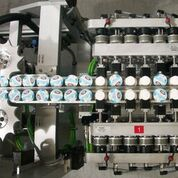 Tackling the demand for reduced plastic packaging is now top of the agenda for retailers, manufacturers and everyone in between since the Blue Planet II TV series highlighted the danger of plastics in our oceans. But changing the approach to sustainable packaging by switching to different materials is just one element to affect change. Machine designers need to use automation to its full potential in order to produce more efficient machinery, Neil Beaumont of Lenze explains
Tackling the demand for reduced plastic packaging is now top of the agenda for retailers, manufacturers and everyone in between since the Blue Planet II TV series highlighted the danger of plastics in our oceans. But changing the approach to sustainable packaging by switching to different materials is just one element to affect change. Machine designers need to use automation to its full potential in order to produce more efficient machinery, Neil Beaumont of Lenze explains
Plastic is everywhere. As you become aware of this, you realise just how superfluous the use of packaging is as you bag up your groceries in plastic bags this week. Eighty years ago though, plastic packaging barely existed.
Whether it’s to extend the shelf life or prevent food waste there are many benefits to plastics but as we’ve seen, it’s with an enormous cost to the environment. The responsibility is now with businesses to make a change and to manage, and handle, material with care.
Apart from moving away from plastics altogether, the most common approach to making packaging more ‘sustainable’ is to use alterative materials. Single materials to replace multi-layer plastic laminates, are easier to recycle, but using biodegradable or compostable plastics will help reduce the risk of pollution.
However, businesses are looking into ways in which the packaging is produced and this means making changes to the machinery that turns the raw plastic into the finished product. This is a highly automated process, consuming large amounts of power – so another critical approach is to make the entire process as smooth and energy efficient as possible.
From an automation standpoint, packaging machines and associated systems such as robotic handling can be extremely challenging. They require a powerful system that can control complex movements along several axes. An effective automation platform needs to deal with complex machine design by providing tools that improve packaging machine performance and reliability – allowing machine builders to design systems that are flexible enough to adapt to changes in materials while running at high efficiency.
 Finding the right automated solution
Finding the right automated solution
Processing compostable plastics will be a challenge as they generally have different physical characteristics to conventional material and so adjustments to processing machinery maybe required. It will take time for packaging companies to shift to using these new materials and are likely to continue processing both conventional and compostable materials – meaning that the machinery they use must be flexible enough to cope with both.
Plastics packaging is also beginning to use increased amounts of recycled material. As a consequence, packaging machinery will have to cope with raw materials that contain an ever-higher proportion of recycled material. Again, their physical properties differ from that of virgin resin, so machinery must be able to handle these conditions. On top of this, the amount of recycling carried out will need to increase – not just at a post-consumer level, but also within production facilities themselves. These in-house recycling facilities, in particular, will need to connect seamlessly with the production operation itself.
The UK Plastics Pact
Forty-two UK businesses including the leading supermarkets and producers like Coca-Cola and Nestle have committed to reducing plastic waste by setting up the UK Plastics Pact by 2025, which has four aims:
• For all plastic packaging to be reusable, recyclable or compostable;
• For 70% of it to be effectively recycled or composted;
• To eliminate single-use packaging as far as possible; and,
• To increase recycled content in packaging to 30%.
 To ensure that machines can cope with these greater demands, automation expertise will be required early on in the machine design to ensure the automation works as efficiently as possible, thereby contributing towards a more sustainable production.
To ensure that machines can cope with these greater demands, automation expertise will be required early on in the machine design to ensure the automation works as efficiently as possible, thereby contributing towards a more sustainable production.
Sophisticated packaging automation system software developed by Lenze will allow easier extraction of data from a system or factory. This can be converted into information that is meaningful and useful, be it for predictive maintenance or further process optimisation.
With connectivity now becoming a normal feature, utilising open platforms and powerful protocols such as CoDeSys, EtherCAT, OPC UA should be part of the automation portfolio – to ensure that products are ready for the ‘smart factory’ environment.
The profound effect from BBC’s Blue Planet II rippled through industry, business and consumer mindset in 2018 and the packaging industry was poised to respond. But it’s the machine designers taking the public mantle, who will ensure that plastic packaging is sustainable and recyclable for future generations

